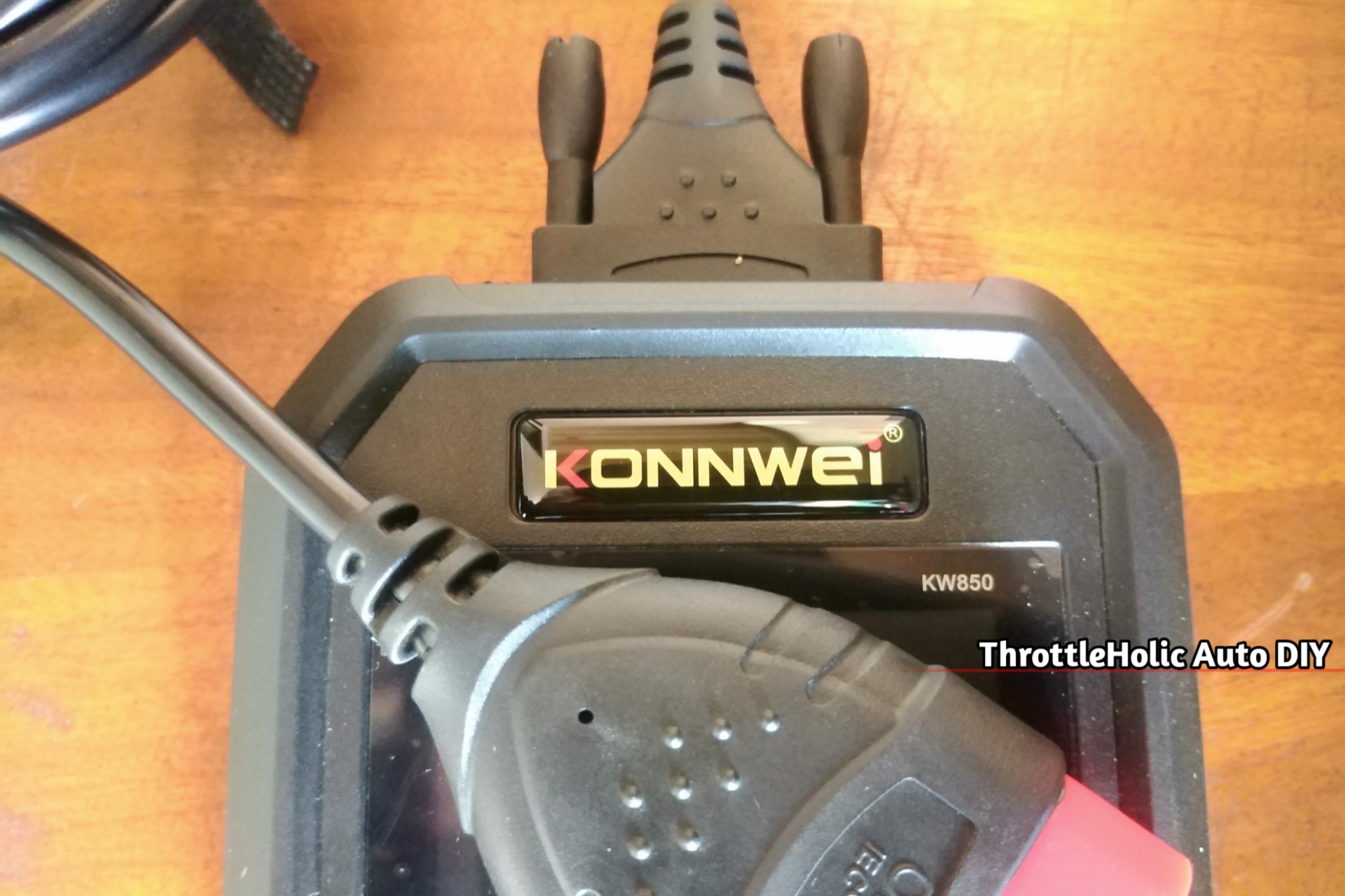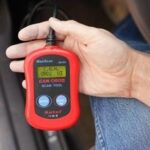I’ll admit, my interest was instantly piqued when my brother showed up with what looked like a serious piece of diagnostic equipment to tackle a check engine light. It was the Konnwei KW850, and having never seen it before, the DIY mechanic in me was immediately drawn to it. This encounter sparked my need to dive deeper and conduct a proper Konnwei Obd2 Review.
What really grabbed my attention initially was its size. In a world of compact gadgets, this scanner was substantial, and I was eager to see what capabilities justified its larger form factor. Even after learning it was classified as a basic code reader, my curiosity only intensified. Why would a basic tool be designed with such a commanding presence?
To truly understand its worth, I spent a week using the Konnwei KW850, putting it through its paces on different vehicles. This Konnwei OBD2 review is based on my hands-on experience, aiming to provide you with a comprehensive look at its features, functionality, and whether it’s the right OBD2 scanner for your needs.
First, let’s take a closer look at the Konnwei KW850 OBD2 scanner itself and what comes in the box.
Konnwei OBD2 Review: Unboxing and Initial Thoughts
When my brother first presented the Konnwei KW850, my first thought was, “Is that some kind of heavy-duty tool?” Its size made a real statement. Even now, having used numerous OBD2 scanners, the KW850 remains the largest basic code reader I’ve encountered. Initially, I even suspected it might be a high-end, all-system scanner capable of advanced diagnostics.
There was a definite “bold” and “badass” vibe to it. I imagined it was packed with features, ready to tackle any diagnostic challenge. Even after my brother clarified its basic nature, I reserved judgment, eager to test it firsthand. I needed to plug it into my own car’s OBD2 port to truly assess its capabilities.
Upon holding the Konnwei KW850 for the first time, its weight was immediately noticeable – substantial and reassuring, much like the Foxwell ST203 I tested in my Foxwell ST201 vs. ST203 comparison.
Looking at the packaging contents, which my brother kindly shared, the Konnwei KW850 includes:
- Eco-friendly cardboard packaging.
- Comprehensive user manual.
- Protective carrying case.
- The Konnwei KW850 scanner unit.
Konnwei KW850 Functions and Capabilities
Given its size, my expectations for the Konnwei KW850’s functionality were quite high. However, plugging it into my vehicle’s OBD2 port brought a dose of reality. While it may look imposing, its core functionalities are firmly in the realm of a basic OBD2 code reader.
Here’s a breakdown of the key functions I explored during this Konnwei OBD2 review:
1. Basic OBD2 Code Reading and Clearing
The primary function of any OBD2 scanner is to read and clear Diagnostic Trouble Codes (DTCs). When your car’s computer detects an issue outside of normal operating parameters, it triggers a DTC and often illuminates the check engine light.
The Konnwei KW850 excels at this basic task. It quickly retrieves these codes, giving you a starting point to understand what’s causing the problem. These codes, while seemingly cryptic, tell a story that can be unlocked with a DTC lookup.
Crucially, after you’ve addressed the underlying issue, the KW850 allows you to clear these codes, turning off the check engine light and giving you a clean slate to monitor for any new problems.
2. Built-in DTC Lookup Function
For those unfamiliar with DTCs, the codes themselves can be confusing. This is where the Konnwei KW850’s integrated DTC lookup feature becomes invaluable. Simply enter the code displayed by the scanner, and it provides a clear, concise explanation of what that code signifies.
This feature bridges the gap between raw data and actionable information, making the diagnostic process accessible even for users who aren’t seasoned mechanics. It’s a key element that enhances the user-friendliness of this konnwei obd2 review unit.
3. Live Data Stream Reading
Beyond just reading codes, understanding what’s happening in real-time is often crucial for accurate diagnosis. The Konnwei KW850 provides live data streaming capabilities, allowing you to monitor various parameters as your vehicle is running.
For example, investigating a lean condition indicated by a P0171 code requires more than just knowing the code itself. Live data allows you to examine the air flow rate (grams per second) and compare it against expected values based on engine size. Deviations can point to issues like vacuum leaks causing unmetered air entry.
This live data feature, while seemingly basic, is a powerful tool for deeper diagnostics and is a significant advantage in this konnwei obd2 review.
Additional Konnwei KW850 Features
Beyond the core OBD2 functions, the Konnwei KW850 includes several helpful supplementary features:
- I/M Readiness: This function checks the status of your vehicle’s emissions systems, ensuring they are functioning within acceptable limits for emissions testing.
- EVAP System Test: Allows you to initiate an EVAP system leak test to diagnose evaporative emissions control system issues.
- O2 Sensor Test: Checks the performance and responsiveness of your vehicle’s oxygen sensors, critical for fuel efficiency and emissions.
- Vehicle Information Retrieval: Displays essential vehicle information like VIN (Vehicle Identification Number), CID (Calibration ID), and CVN (Calibration Verification Number).
- Data Review and Print: Allows you to review saved DTCs, freeze frame data, and live data streams. You can also print this information if you need a hard copy for records or further analysis.
Konnwei KW850 Vehicle Compatibility
Vehicle compatibility is a primary concern when choosing an OBD2 scanner. The Konnwei KW850 boasts broad compatibility with modern vehicles. In my testing for this konnwei obd2 review, I successfully used it on various makes and models (excluding hybrids, sports cars, and electric vehicles) without any issues.
It’s important to remember that the vehicles I tested were all OBD II certified. If you own an older vehicle that might be OBD I compliant, it’s advisable to verify compatibility directly with Konnwei’s manufacturer.
However, for the vast majority of drivers with OBD II compliant vehicles (excluding specialized categories), the Konnwei KW850 should offer reliable compatibility.
Battery Testing and OBD I Support
One standout feature of the Konnwei KW850, and somewhat uncommon in basic OBD2 scanners, is its integrated battery testing capability. While some scanners like the Ancel AD410 Pro also offer this, it’s not a standard feature.
The KW850 allows you to test your car battery’s voltage and state of health directly through the OBD2 port, a significantly more convenient method than traditional battery testers that require direct terminal connections. As I confirmed with a multimeter, the readings were accurate. This feature is particularly useful for diagnosing no-start conditions and is a definite plus in this konnwei obd2 review.
Furthermore, the Konnwei KW850 also supports OBD I vehicles, a valuable feature for those working on older cars. While OBD I vehicles are less common now, having this capability built-in adds to the scanner’s versatility.
Konnwei KW850 Limitations
No konnwei obd2 review would be complete without discussing its limitations. Despite its robust appearance and helpful features, the KW850 does have some drawbacks:
1. Size and Limited Functionality
The most prominent limitation is its size relative to its functionality. Despite being a large device, the Konnwei KW850 remains a basic OBD2 code reader. It does not offer advanced features like:
- Transmission diagnostics
- ABS (Anti-lock Braking System) diagnostics
- Airbag system diagnostics
- Advanced system scans
For its size, some users might expect more comprehensive diagnostic capabilities.
2. Detachable Cable
The detachable OBD2 cable can be both a pro and a con. Detaching the cable makes storage easier and potentially reduces wear and tear on the cable itself.
However, a detachable cable also presents a risk of loss or misplacement. If you’re not meticulous about keeping track of the cable, you could find yourself with a scanner that you can’t connect to your vehicle.
Konnwei KW850 Alternatives
If you’re considering the Konnwei KW850, it’s worth looking at some alternatives:
- Ancel AD410: A compact and reliable OBD2 scanner that I’ve personally used for years. It’s a great basic code reader and a strong contender if size is a concern. Read my Ancel AD 410 review for more details. Ancel AD 410 on Amazon
- Ancel AD410 Pro: An upgraded version of the AD410 that includes battery testing, similar to the Konnwei KW850, but in a smaller form factor. Ancel AD410 Pro on Amazon
- Foxwell NT301: If you prefer a larger scanner but want to explore other brands, the Foxwell NT301 is another sizable option with similar basic OBD2 functionalities. Read my Foxwell NT301 review for a comparison.
Final Verdict: Should You Buy the Konnwei KW850?
The Konnwei KW850 OBD2 scanner makes a statement. Its size and solid build quality project an image of capability and robustness. If you appreciate a tool that feels substantial and makes an impression, the KW850 certainly fits the bill.
For users who prioritize a basic, easy-to-use OBD2 scanner with added battery testing and OBD I compatibility, the Konnwei KW850 is a viable option. It delivers on its core functions and provides a user-friendly experience, especially with its DTC lookup feature.
However, if you prefer a more compact scanner or require advanced diagnostic features beyond basic code reading, alternatives like the Ancel AD410 or more advanced scanners might be a better fit.
Ultimately, the best choice depends on your individual needs and preferences. If you value a robust-feeling, feature-rich (for a basic scanner) tool with OBD I support and battery testing, the Konnwei KW850 is a solid contender. But if size and advanced features are less of a concern, other options offer comparable or even superior value.
Stay Tuned for More Auto DIY Reviews!
Throttle Lan
DIY Mechanic & Auto Content Creator
With half a decade of hands-on car repair experience, I’m passionate about all things automotive. From engine rebuilds to routine maintenance, I enjoy tackling any mechanical challenge. When I’m not in the garage, I’m sharing my knowledge and experiences through writing.

